![]()
![]()
![]()
Use LEFT and RIGHT arrow keys to navigate between flashcards;
Use UP and DOWN arrow keys to flip the card;
H to show hint;
A reads text to speech;
38 Cards in this Set
- Front
- Back
|
What are the 3 types of muscle tissue? |
1. Skeletal
2. Cardiac
3. Smooth (visceral) |
|
|
Skeletal - Muscle Tissue
striated? voluntary? |
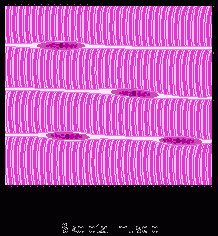
Striated? Yes
Voluntary? Yes |
|
|
Cardiac - Muscle Tissue
Striated? Voluntary? |
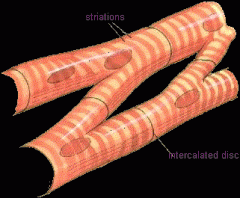
Striated? YES
Voluntary? NO |
|
|
Smooth - Muscle Tissue
Striated? Voluntary? |

Striated? NO
Voluntary? NO |
|
|
identify origin and insertion |
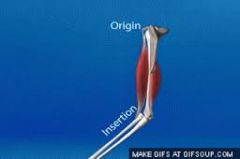
|
|
|
During contraction the ___ moves toward the ___? |
During contraction the insertion moves toward the origin |
|
|
Name the 5 functions of muscles |
Muscle functions include: * motion* locomotion * maintenance of posture or position * production of heat * circulation of the blood |
|
|
Muscles function in? |
in pairs or groups, each having the opposite function of the other. |
|
|
Muscles that flex the forearm , must be complemented by? |
by muscles that extend the same structure |
|
|
The Muscle mass itself is referred as? |
The belly |
|
|
What is the origin? |
the end of the muscle that is relatively stationary during contraction. |
|
|
What is insertion? |
the end of the muscle that moves toward the origin during contraction. |
|
|
Rarely, a muscle origin can act as the insertion
T/F |
True |
|
|
Give an example, where the muscle origin can act as the insertion |
In the rectus abdominus where the xiphoid process and the pubic symphysis can interchangeably be the origin or insertion depending on the action being performed. |
|
|
What is superficial fascia? |
a layer of shiny connective tissue |
|
|
What is epimysium? |
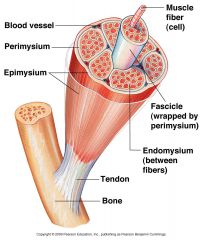
the outermost layer of the muscle |
|
|
What is the Perimysium? |
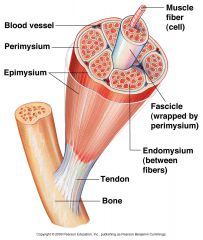
Deep to the epimysium and surrounding the fasciculi |
|
|
What is the Endomysium? |
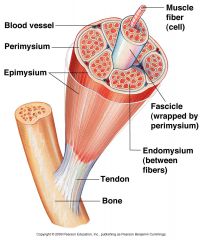
They are within each fasciculus and surrounding the muscle fibers that lie inside is the muscle layer |
|
|
What is the Fasciculus ? |
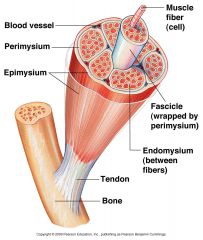
can be viewed as a cylindrical area within the muscle containing parallel-running muscle fibers |
|
|
What is a muscle fiber? |
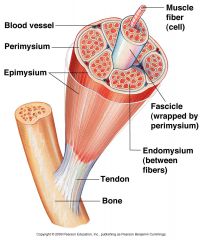
A muscle fiber is a muscle cell |
|
|
What is a myofibril? |
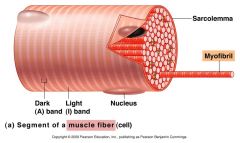
Rod that is striated , comes out of muscle fiber |
|
|
What is Sarcomere? |
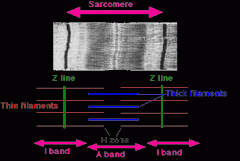
the portion of a muscle fiber between two successive Z-lines |
|
|
What is the Z line or Z disc ? |
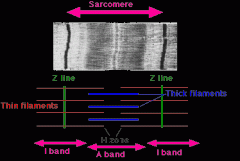
the partitions within a muscle fiber that section it into sarcomeres. Thin myofilaments attach to these. |
|
|
What is an A band? |

the comparatively dark area entirely within a sarcomere. This area is composed of thick filaments and thin filaments. This area does not shrink during muscle contraction. |
|
|
What is the I band? |
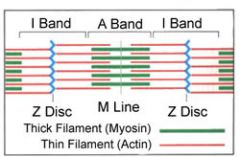
the lighter areas alternating with A-Bands; these areas straddle the Z-line and are composed of thin filaments (the terms myofilament and filament are used interchangeably). During contraction the I-Band shrinks in size. |
|
|
What is the H zone? |
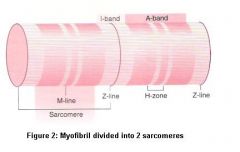
a subdivision of the A-Band in the center of the sarcomere where only thick filaments are present. This area shrinks during muscle contraction. |
|
|
What are Thick Filaments? |
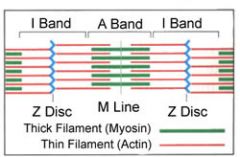
these filaments, which span A-Band, are composed of the protein myosin.
|
|
|
What are Thin Filaments? |
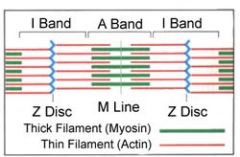
these filaments, which attach to the Z-line and interdigitate with the thick filaments, are composed of three proteins: * f-actin* tropomyosin * troponin (attaches to the end of each tropomyosin strand |
|
|
The release of Calcium ions to initiate muscle contraction allows , calcium to bind to? |
allows Ca to bind to troponin |
|
|
When calcium binds to troponin , what happens? |
troponin moves slightly and allows myosin to bind with tropomyosin |
|
|
When troponin moves slightly and myosin binds with tropomyosin, what does this allow? |
This permits the movement (sliding) of the thick and thin filaments over each other. |
|
|
During Muscle contraction , what happens? |
the thick and thin filaments overlap eachother more and more. Movement of the filaments is described in the Sliding Filament Theory. |
|
|
During the contraction, the thick filaments appear to? |
maintain their position in the center of the sarcomere |
|
|
During contraction , what happens to the sarcomere? |
the sarcomere itself becomes smaller as the Z-lines "move in" on the thick filaments |
|
|
Since all of the sarcomeres in a muscle contract but the origin remains stationary, the result is ? |
the result is that the insertion is moved toward the origin. |
|
|
Thick filament is composed of what? |

Myosin (beads) |
|
|
Thin filaments are composed of what 3 proteins? |

1. F - Actin
2. Tropomyosin
3. Troponin |
|
|
In a short summary, what is the sliding filament theory? |
During contraction, Troponin and Myosin , can form bonds and move relative to each other |

